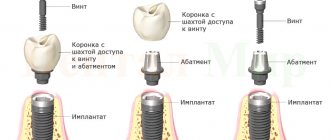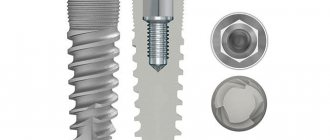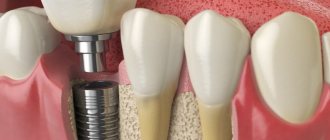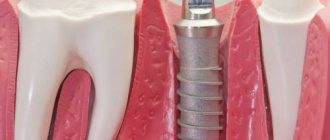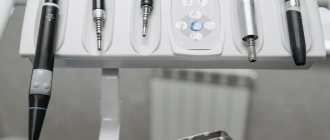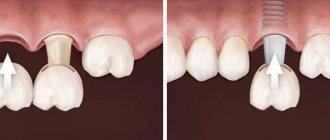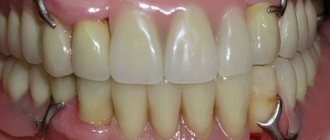Plate or lamellar dentures are one of the most common and affordable types of removable prosthetics. At the same time, as patients note, it is the most uncomfortable. Plate dentures are created from an acrylic base and attached plastic crowns. There are two types of plastic:
- hard plastic – these are the usual plate prostheses, very hard and quite uncomfortable, but at the same time accessible to a wide range of patients
- soft plastic - this group includes flexible and very comfortable nylon prostheses, which are a type of plate prosthesis. They are distinguished by incredible comfort and quick adaptation, but their cost is several times higher than prostheses made of hard plastics
Complete plate denture RUB 32,000. for all!
The price includes: diagnostics, impressions, manufacturing, installation, fitting and 1 year warranty! Swiss methods and quality in Russia!
Plate prostheses: indications for use
- missing one or more teeth
- edentia - the complete absence of teeth in a row (it is in this case that plate dentures play the role of the familiar “false jaw”)
On the upper jaw, plate dentures can completely cover the palate, on the lower jaw they can rest solely on the gums, or they can be attached to natural teeth using metal hooks. Made from soft plastics, nylon plate dentures are very securely attached (sucked) to the gums, without causing discomfort or inconvenience to the patient. Dentures made of hard plastics do not fit so well; they often rub the gums, and the metal hooks with which the dentures cling to the living teeth of the oral cavity are visible during communication and wear away the enamel of the teeth over time.
Advantages of plate dentures
- the most inexpensive type of removable prosthetics
- uniform distribution of chewing load on bone tissue
- easy care of dentures
- fast production and easy installation
Disadvantages of plate prostheses
- made of hard plastics, dentures can rub the gums throughout the entire period of wear, causing pain and discomfort
- decreased sensitivity because dentures cover major taste buds
- discomfort while eating
- diction may change
- Regular examinations by the dentist are required (the dentures themselves and the gums underneath them)
Plate dentures on implants
Implants used to support dentures partially reduce the number of deficiencies. For example, plate dentures put less pressure on the gums, do not cause pain and discomfort, and do not change diction. Often, it is plate dentures that are used to replace the entire dentition, installing them as permanent or removable structures.
Caring for plate dentures does not cause problems for the owner. We recommend removing them at night to give your gums a break from the stress. Twice a day, morning and evening, they need to be cleaned of plaque using special brushes and toothpaste, and also rinsed after eating.
Other jobs
What is a removable plate prosthesis?
A removable plate prosthesis is a base made of polymer materials into which artificial teeth are inlaid. This design is used in the absence of several or all jaw teeth, and due to the low cost and ease of manufacture, removable plastic laminar dentures are very popular among patients.
Indications
The indications for the use of removable plate dentures for teeth are very wide, since there are much fewer restrictions for this type of system than for implantation or classical dental prosthetics. In particular, these are:
- complete or partial edentia;
- impossibility of implantation or classical prosthetics (for clinical or financial reasons);
- the need to wear temporary structures before installing permanent dentures;
- allergy to metal.
Contraindications
- severe periodontal diseases;
- problems of the circulatory system;
- undergoing a course of radiation or chemotherapy;
- mental illness.
The materials for making plate dentures are usually plastic, acrylic, nylon or polyurethane. Often, it is the composition that largely influences the final cost of the design: modern plate dentures are made of hypoallergenic acrylic or nylon, which ensures comfortable wearing and almost completely eliminates allergic reactions. Based on appearance and functionality, these prostheses are divided into two types: partial laminar dentures and complete laminar dentures. Let's look at these systems in more detail.
Possible complications after implantation
According to independent estimates by practicing dentists, complications after the installation of plate implants can occur in 30-40 people out of 100. And this is indeed a very large figure, because When installing classic root-shaped models, the risk of complications has not exceeded 1-5% for a long time. Let's consider what consequences and complications a patient may encounter after implantation:
- severe swelling after surgery: because a large amount of tissue is injured,
- long healing period, i.e. on sick leave for a long time,
- mobility of the installed implant: often soft tissue rather than bone is formed around the plate implant,
- peri-implantitis and rejection.
Read on the topic: what is dental implant rejection – why does it happen and what can be done?
Partial plate denture
A partial removable plate denture replaces one or more lost teeth, so its shape and size directly depend on their number. To install such a prosthesis, you do not need to grind down the adjacent teeth: fixation of partial removable laminar dentures is carried out in several ways.
Types of fixation of removable laminar dentures:
Metal clasps
Hook-shaped processes starting at the base of the prosthesis and clasping the neck of the supporting tooth. Currently, they are rarely used, as they can damage tooth enamel.
Metal-free clasps
A more modern variation of conventional clasps. Made from soft, metal-free materials.
Attachmen
Small clasps that are installed on the prosthesis itself and the supporting teeth. When installing the structure, these parts are securely fixed.
Features of installing implant plates
The introduction of plate structures into the bone took place in several stages:
- After antiseptic treatment, an incision was made in the mucous membrane, the size of which was slightly larger than the width of the plate.
- The mucoperiosteal flap was separated from the bone.
- Vertical channels were drilled into the jaw to a depth corresponding to the height of the subgingival part of the implant.
- The holes were connected to each other to form a groove for the plate.
- The prepared bed was treated with antiseptics, and the implant was placed into it.
- The tissue flap was returned to its place, and sutures were applied.
Complete removable plate denture
Removable laminar dentures in the case of complete absence of teeth simulate the patient’s upper or lower jaw, so that they are significantly larger in size than removable laminar dentures in the case of partial absence of teeth. As a rule, such a design has a rather voluminous base (especially a plate prosthesis for the upper jaw), which is necessary in order to achieve a tight fit and ensure more or less stable fixation.
Methods of fixation of complete removable laminar dentures:
Clasps or attachments
Such fixation methods are used if at least a pair of healthy teeth remain on any of the jaws.
Suckers
Additional fixation elements that are usually used when a complete removable plate denture is installed on the upper jaw.
Fixation on implants
Installation of a prosthesis supported by implants. This is the most reliable, expensive and durable method of prosthetics, which is not always possible due to contraindications to implantation and the high cost of the technique.
What are plate-type dental implants?
Many people are interested in which rods appeared first - lamellar or root-shaped. Historically, the first attempts were made to implant animal teeth in humans back in the 18th century. The era of artificial implants began only in the middle of the 20th century, when dentistry began to use dental roots made of titanium, imitating the shape of natural ones.
Since 1967, Blade-Went plate implants, proposed by Linkow LI, became popular and were improved by the 80s. By that time, specialists had already mastered the principles of antiseptics, which significantly reduced the risk of rejection of implantation systems.
At first, plate implants were made as one piece (non-separable), but then composite structures from individual elements appeared. Subsequently, they began to be used in cases where root-shaped models cannot be used.
Manufacturing of plate dentures
The technology for manufacturing a plate prosthesis is considered simpler compared to the creation of most fixed structures (crowns or bridges), so the patient receives a ready-made system quite quickly (unless we are talking about installing implants).
Manufacturing stages:
- Initial consultation, examination, creation of panoramic images of the jaw and approval of the design of the prosthesis.
- Taking impressions and making a model of the patient's jaw. Determination of bite parameters.
- Making and fitting of a wax structure.
- The final stage of manufacturing a plate prosthesis, polishing the finished structure and eliminating cosmetic defects.
- Fitting and installation of the finished structure.
Stages of implantation
The installation of plate implants is carried out in accordance with the traditional two-stage method and includes the following steps:
- anesthetic injection (“freezing”),
- preparing the bed for the implant: a long incision is made on the gum, the tissue is peeled off (flap surgery). Next, several holes are drilled into the bone, which need to be combined into one long “slot”,
- installation of an implant in the bed,
- suturing.
When the implants take root, the doctor will install abutments, and on them a full-fledged prosthesis with which you can chew food. This applies to two-piece models. If single-component structures were used, then after implantation a lightweight prosthesis is placed on their supragingival parts, removed from the bite while the implants are healing (if you immediately put a large load on them, the systems simply will not take root).
Advantages and disadvantages
Prosthetics with plate prostheses have a number of advantages and disadvantages, which may vary depending on the type of structure. Before agreeing to have dentures installed, find out all the strengths and weaknesses of your new teeth. In addition, your attending physician should tell you about the types of plate prostheses and help you choose the best option.
- fragility (under heavy loads, a fracture of the plate prosthesis often occurs);
- short service life (up to 5 years);
- certain discomfort when wearing and difficulty getting used to (this applies to a greater extent to outdated designs);
- no load on bone tissue (except for installation supported by implants).
- ease of manufacture;
- low price. Prosthetics with removable plate dentures are considered one of the most cost-effective options for dental restoration in orthopedics;
- restoration of chewing function of teeth;
- acceptable appearance.
What are the alternatives?
The most adequate alternative to plate implants is root-shaped models (classic length or zygomatic). Their design is as close as possible to the shape of natural roots, installation is carried out using the “puncture” method, and the risk of rejection is 1-2%. Such implants, which are of very high quality, durable and have been tested in practice for more than 40 years, are available from the brands Nobel Biocare and Straumann.
Also, modern models from Oneway Biomed for basal implantation are suitable for patients with thin bone. Unlike previous generations of basal ones, which were distinguished by their large size and very traumatic installation, today such systems are installed minimally invasively, are rejected extremely rarely (in the same 1-2% of cases), and are actively used in patients with periodontitis and periodontal disease.
“I have almost no normal teeth left in my mouth. And those that survived were already wobbly, their gums were constantly bleeding, in general, there was little that was pleasant and beautiful. The dentist suggested doing basal implantation. In general, while I was thinking and looking for information, I realized from the reviews that such implants are very massive and they are generally terrible to install, they require a lot of sawing of the bone. But the doctor told me that this is already the last century, and now no one installs such implants, but there are more modern and very thin ones.”
Artem, review from the site irecommend.ru
Repairing a plate denture for teeth
Constructions of this type are considered quite fragile, especially at the point where the soft supporting part is attached to the artificial teeth. Repairing removable plate dentures is not always possible, and the degree of its success depends on the nature of the damage. In case of minor chips or breakage of clasps and attachments, restoration of removable plate dentures is often carried out, but in case of serious damage, the design usually has to be completely changed. The main reasons for the breakdown of plate dentures usually lie in careless handling (which often leads to falls of the structure) and attempts to bite through hard objects with dentures (for example, nut shells).
Prices
| Service | Price |
| Removable acrylic (plate) dentures | from 15,200 rub. |
| Taking a two-layer impression | from 900 rub. |
| Taking an alginate impression | from 500 rub. |
| Restoration of a removable denture | from 3500 rub. |
To avoid possible misunderstandings, please clarify the cost of services in clinics with the administrator or during a consultation with a doctor. Prices on the website are not a public offer.
Sign up for a consultation
